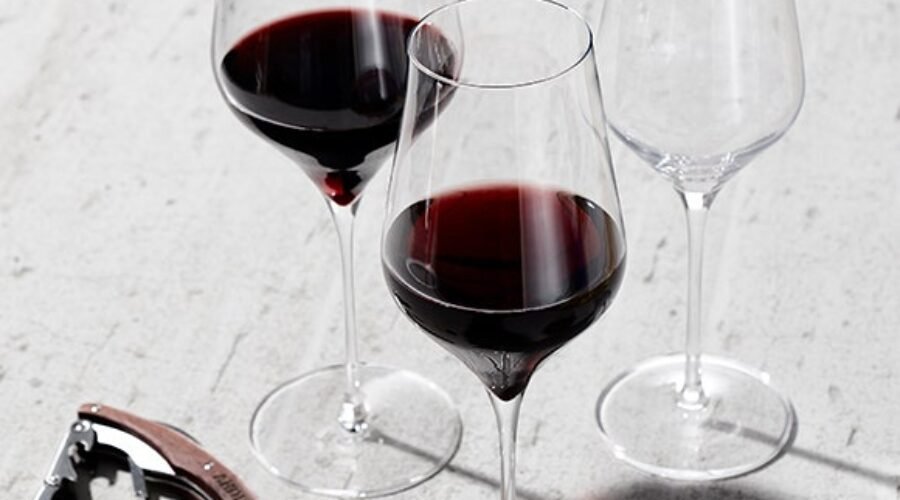Smoke Taint Research Set Ablaze as Trump Cuts Federal Funding
Last Thursday, thousands of government employees across the country sat down with their supervisors and received the news: Their positions were cut.
The culling included two of the country’s leading smoke taint researchers, Arran Rumbaugh and Torey Arvik. Rumbaugh has been leading a years-long research program with the USDA Agricultural Research Service (ARS) to understand the effects of wildfire on grapevines and find new remediation methods for grapes and wine impacted by smoke—an increasingly common occurrence in the age of climate change.
Four other ARS grape researchers (four in California, one in Washington, one in New York) also lost their jobs. “Right now we don’t have a single scientist solely dedicating their research on smoke taint in California,” says Rumbaugh of the ARS.
It’s grim news. The California wine industry suffered nearly $4.2 billion in smoke taint damage from the devastating blazes of 2020 alone. The path forward is uncertain—currently, there are no fail-safe solutions to remedy the wine fault.
“Smoke has been one of the biggest economic impacts for the wine industry in recent years,” says Alisa Jacobson, the winemaker at Turning Tide and co-chair of the West Coast Smoke Exposure Task Force subcommittee on research. “It’s really discouraging.”
Both lawmakers have joined the chorus of industry experts sounding the alarm on the potential long-term impacts.
“In firing the only two smoke exposure researchers in our region, Elon Musk and his Republican enablers are not only throwing out a decade of research progress, they are making it harder for our agriculture producers to recover after wildfires strike,” Congressman Mike Thompson said in a recent press release. “The only waste, fraud and abuse here is that losing this research is a waste.”
Research Set Aflame
Rumbaugh’s role was created after fires ravaged the West Coast in 2020. Her mission: understand grapevines’ physiological responses to smoke, find ways to salvage smoke-impacted grapes and develop rapid smoke-impact detection tools.
Rumbaugh and her team have been working in tandem with colleagues in Oregon, Washington and New York to find ways to combat the next great fire event.
“In some ways I see this as a slap to the face of the grape and wine industry,” says Rumbaugh. “After the 2020 fires, they asked for support. They received it, and now it’s being taken away.”
That year, between 165,000 to 325,000 tons of California grapes were left to waste because of wildfire smoke, resulting in billions of dollars of economic loss. More than 4.3 million acres burned throughout the state.
“Wildfires are only becoming more frequent and severe in California and beyond,” says Natalie Collins, president of the California Association of Winegrape Growers. “This research is critical.”
In the last five years, fires have decimated California, Oregon, Washington, British Columbia and Quebec. Another 4.2 million acres-plus have burned across the Golden State during this time.
“You don’t have to believe in climate change to be worried about fire,” says Jacobson. “They’re very real.”
When the 2020 fires hit some winemakers scrapped the vintage entirely, some released wines kissed with smoke and others salvaged red grapes by pressing them into white wines.
There were no perfect remedies for those affected. “The best way to test is currently to do a micro-fermentation,” says Jacobson. “The winery would be responsible for picking a grape sample, fermenting it on a small scale and sending that off to the lab. It’s labor intensive and expensive.”
Rumbaugh and team were working to find solutions that winemakers and growers could apply to save their grapes when fires hit.
Scorching Results
Recently, Rumbaugh has been working on passive samplers: absorbent tubes that can be placed in a vineyard to absorb the smoke concentration.
“We can then measure compounds in that smoke and correlate it with impacts on grapes and wines,” says Rumbaugh. “It would be a cheap and readily-available method for monitoring smoke impacts in a vineyard via a rapid screening method.”
It’s huge progress from where the industry was in 2020, when it would take three to seven weeks to get results from a test back.
With her role eliminated, these kinds of advancements could be lost.
“That’s our biggest concern—momentum,” says Collins. “We were making so much progress. It’s challenging to see this all come to an end overnight.”
Only three researchers in the private-public wine grape industry group West Coast Smoke Exposure Task Force (WCSETF) are left.
In January, Anita Oberholster, one of the leading smoke taint researchers and a huge resource and light in the industry (and a 2022 Wine Star Award winner), lost her battle with cancer—yet another tough blow to the cause.
let adType_67b8fdc29ef86 = “leaderboard”;
// Create the element
let script_67b8fdc29ef86 = document.createElement(“script”);
script_67b8fdc29ef86.innerHTML = `
window.googletag = window.googletag || {cmd: []};
googletag.cmd.push(function() {
var mapping;
// Size mapping for leaderboard ads
var lbmapping = googletag.sizeMapping()
.addSize([1024, 0], [[970, 250], [970, 90], [1, 1], [728, 90]])
.addSize([728, 0], [[728, 90], [1, 1]])
.addSize([320, 0], [[1, 1], [300, 50], [300, 100], [320, 50], [320, 100]])
.addSize([0, 0], [[1, 1], [320, 50]])
.build();
// Size mapping for med rectengle ads
var medrecmapping = googletag.sizeMapping()
.addSize([1024, 0], [[300, 600],[300, 250]])
.addSize([728, 0], [300, 250])
.addSize([320, 0], [[1, 1],[300, 250]])
.addSize([0, 0], [[1, 1], [300, 250]])
.build()
//var lbSlots = [[[320, 100], [728, 90], [300, 100], [1, 1], [300, 50], [970, 250], [320, 50], [970, 90]]];
//var medrecSlots = [[300, 600], [1, 1], [300, 250]];
mapping = adType_67b8fdc29ef86 == ‘leaderboard’ ? lbmapping : medrecmapping;
googletag.defineSlot(‘/39808611/article_page/article_leaderboard_1’, [],
‘div-gpt-ad-67b8fdc29ef86’).addService(googletag.pubads()).defineSizeMapping(mapping);
googletag.pubads().enableSingleRequest();
googletag.pubads().collapseEmptyDivs(); //maybe optional
googletag.pubads().refresh(); //maybe optional
googletag.enableServices();
});
`;
//checking to see if script is inserted in the header successfully
if (document.head.appendChild(script_67b8fdc29ef86)) {
//variable holding the rendering body
document.getElementById(“gptBodySection-67b8fdc29ef86”).innerHTML = `
googletag.cmd.push(function() { googletag.display(div-gpt-ad-67b8fdc29ef86); });
`;
}
Agricultural Funding Cuts All Around
While the loss of smoke taint research has been a hard hit for the wine industry, it wasn’t the only sector hit.
The Trump administration is in the midst of pausing reviews on all federal funding, with the goal of cutting $230 billion in agriculture spending. At the time of publication, these drastic government cutbacks have slashed over 200,000 federal jobs, a move being called “The Valentine’s Day Massacre.”
Rumbaugh, along with thousands of other probationary employees (a period that can last three years), were told their roles were not a fit for the agency’s current needs, and let go without severance.
“It’s heartbreaking. I put a lot of my time, effort and heart into this,” says Rumbaugh. “I have to immediately think of how I can pay bills, but I would love to still do this work.”
While cutting the ARS’s smoke taint research may save the federal government money off the jump, it will be costly in the long run.
let adType_67b8fdc29f86e = “leaderboard”;
// Create the element
let script_67b8fdc29f86e = document.createElement(“script”);
script_67b8fdc29f86e.innerHTML = `
window.googletag = window.googletag || {cmd: []};
googletag.cmd.push(function() {
var mapping;
// Size mapping for leaderboard ads
var lbmapping = googletag.sizeMapping()
.addSize([1024, 0], [[970, 250], [970, 90], [1, 1], [728, 90]])
.addSize([728, 0], [[728, 90], [1, 1]])
.addSize([320, 0], [[1, 1], [300, 50], [300, 100], [320, 50], [320, 100]])
.addSize([0, 0], [[1, 1], [320, 50]])
.build();
// Size mapping for med rectengle ads
var medrecmapping = googletag.sizeMapping()
.addSize([1024, 0], [[300, 600],[300, 250]])
.addSize([728, 0], [300, 250])
.addSize([320, 0], [[1, 1],[300, 250]])
.addSize([0, 0], [[1, 1], [300, 250]])
.build()
//var lbSlots = [[[320, 100], [728, 90], [300, 100], [1, 1], [300, 50], [970, 250], [320, 50], [970, 90]]];
//var medrecSlots = [[300, 600], [1, 1], [300, 250]];
mapping = adType_67b8fdc29f86e == ‘leaderboard’ ? lbmapping : medrecmapping;
googletag.defineSlot(‘/39808611/article_page/article_leaderboard_2’, [],
‘div-gpt-ad-67b8fdc29f86e’).addService(googletag.pubads()).defineSizeMapping(mapping);
googletag.pubads().enableSingleRequest();
googletag.pubads().collapseEmptyDivs(); //maybe optional
googletag.pubads().refresh(); //maybe optional
googletag.enableServices();
});
`;
//checking to see if script is inserted in the header successfully
if (document.head.appendChild(script_67b8fdc29f86e)) {
//variable holding the rendering body
document.getElementById(“gptBodySection-67b8fdc29f86e”).innerHTML = `
googletag.cmd.push(function() { googletag.display(div-gpt-ad-67b8fdc29f86e); });
`;
}
“Fires are a huge economic problem for the wine industry,” says Jacobson. “We get crop insurance at the national level. Crop insurance pays out whenever there’s a fire. Research should be helping so the government doesn’t have to pay as much during incidents. These funding cuts really affect top to bottom.”
Alongside cuts in the ARS’s smoke taint division, roles in grape breeding, grapevine viral diseases and precision viticulture as well as a vine mealybug project were cut.
And this slash-and-burn approach extends far beyond the wine industry.
The USDA’s Natural Resources Conservation Service (NRCS) had its funding frozen. US Meat Animal Research Center in Nebraska—which handles meat safety and combats foreign animal diseases—had its staffing hacked. At the National Bio and Agro-Defense Facility, 28 people were fired including researchers working on avian influenza (a k a bird flu), which has been recently spreading at a rapid pace. Eight other USDA inspectors, who monitored invasive species, were also fired.
There’s an air of uncertainty for all industries that receive federal funding—the cuts and freezes have hit family farmers, be it ranchers or winegrowers, hard. Many feel shocked and slighted: the administration promised to protect small farmers. Instead, many feel left out in the cold.
Critical research on the spotted lanternfly, an invasive species threatening the wineries across the continent, has also faced uncertainty. The proposed $5.8 million, five-year grant would target the spotted lanternfly, which has decimated east coast vineyards.
The planthopper has been threatening vineyards around Charlottesville, Virginia, home to Trump Winery. In 2024, it made the jump to California.
Adding Insult to Pre-Existing Injury
The news of funding cuts is one more burden the wine industry has to bear. Sales have been slumping, new generations have been slow to connect with wine and oversupply has hit the West Coast hard.
“We’re already struggling,” says Jacobson. “We’re trying to stay with the times, and stay with the new generation of wine drinkers, then we get another curve ball like this.”
The next steps are up in the air. The funding cuts were sudden. Rumbaugh’s research was embedded in the campus at UC Davis, so her work is in the hands of other academics, though there’s no one to clear person pass the torch to next. The work she has started can continue, but there will be no funding for new projects for the foreseeable future.
“This research is important,” says Rumbaugh. “My removal doesn’t diminish the importance of our research. It just makes it harder to achieve.”
More Agriculture Coverage
- Can Champagne give up farming with chemicals?
- Rivers have sustained vineyards for centuries. Wineries are now trying to return the favor.
- Your favorite organic wine may not be ‘organic’ anymore.
- Regenerative certifications are booming right now. Are they worth it?
- Your guide to sustainable wine certifications.
From the Shop
Find Your Wine a Home
Our selection of red wine glasses is the best way to enjoy the wine’s subtle aromas and bright flavors.
The post Smoke Taint Research Set Ablaze as Trump Cuts Federal Funding appeared first on Wine Enthusiast.


